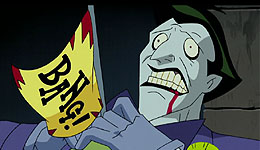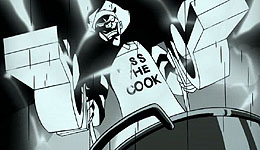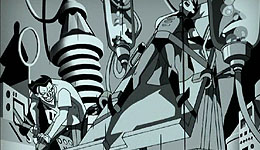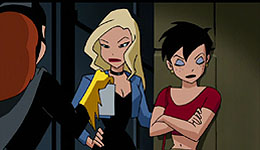 |
Killing
the Joker
Posted:
June
14, 2001; Revised June 4, 2002
 So
by now everyone knows about the Batman Beyond: Return of the Joker
fiasco: Last minute edits ordered by the studio altered the key flashback
sequence by changing the manner of the Joker's death (while also toning
down some of the fight scenes). And everyone (by which I mean, of course,
fanboys like you and me who hang out at message boards and websites) got
quite cross when they heard about the cuts. Hell hath no fury like a fanboy
messed with, and the ire was barely assuaged even after Warners released
an "unedited cut" restoring the altered footage.
So
by now everyone knows about the Batman Beyond: Return of the Joker
fiasco: Last minute edits ordered by the studio altered the key flashback
sequence by changing the manner of the Joker's death (while also toning
down some of the fight scenes). And everyone (by which I mean, of course,
fanboys like you and me who hang out at message boards and websites) got
quite cross when they heard about the cuts. Hell hath no fury like a fanboy
messed with, and the ire was barely assuaged even after Warners released
an "unedited cut" restoring the altered footage.
More surprisingly, once the initial fuss died down a number of voices were raised defending the changes—or, to be more accurate, arguing that the changes had not weakened the original film, and maybe had even improved it.
It is an interesting proposition these viewers advance; it is a respectable proposition. But it is a false one. (But see Alex Weitzman's ingenious defense of the edited version.) And like most interesting, respectable, and false propositions, getting at the fallacy is both difficult and rewarding. In the case of Return of the Joker, whose complex story centers upon that flashback and on Robin's attack on the Joker, it is especially important to be clear about the meaning of the censored sequences, for misapprehensions here will color one's understanding of the rest of the film.
Now, those who defend the changes advance one or both
of the following claims: First, the Joker's death need not be graphically
shown to be effective. The death of the Flying Graysons in "Robin's
Reckoning," for instance, is artfully oblique: a fraying rope,
a gasping audience, an empty trapeze. Second, they observe, as part of
his "makeover" Robin suffers the agonies of controlled electrocution,
and so his simply shooting his torturer doesn't begin to repay the Joker
in his own cruel coin; electrocution does. Furthermore, because Batman
and his team do not kill, Robin's original act is out of character. So
the revised sequence, in which the Joker dies in an electrical accident,
fittingly resolves Robin's torture while sparing him the ignominy of violating
his moral code. On the surface, that flashback is quite isolated from
the rest of the material; the overall film really seems to be about Terry
McGinnis and the (well, the title says it all, doesn't it?) return of
the Joker after many years' absence. The flashback is apparently its own
self-contained story, dropped in to explain what happened a long time
ago—as well as to dollop out some juicy gossip to the fans—and
the Joker's death just rounds off a story which ended a long time ago.
And if this is how the film works, then the edits' defenders have a strong
case. An independent story, after all, requires its own legitimate and
cathartic climax. But the death-by-speargun finale is not cathartic because
it does not properly balance against what was done to Robin. Yet once the entire plot unfolds, Return of the Joker
clearly becomes the story of Robin's trauma. While under his "tutelage,"
we learn, the Joker planted a mind-controlling microchip on Drake, and
has been slowly taking form again in the body of one of Batman's key allies;
the film itself begins when this long-range aspect of the Joker's plot
reaches fruition. Thus, events in the life of the old Bruce Wayne and
his new protégé are not a related but independent sequel
to the flashback, but a decisive proof that the story in the flashback
is still developing, and has yet to reach its true climax. In other words, Return of the Joker is not about
the reappearance of the Joker, but about the ruin of Tim Drake, his estrangement
from Bruce Wayne, and his ultimate redemption. This story stretches over
an arc of forty (or so) years, and is only resolved at the end of the
film. And so those who look for a climax at Arkham fail to appreciate
the deep integration of the flashback into the surrounding material. The corollary is also clear: If the story that begins
during that flashback is not resolved with the Joker's death at Arkham,
then the climax to that flashback should not resolve the story
of Tim's torture and humiliation. Indeed, the resolution of the flashback
should unequivocally lack the air of proper finale. As for Robin's complicity in the Joker's death. This
also makes sense in the context of the overall film. Robin's killing the
Joker is plainly a betrayal of all he has stood for, and so demonstrates
the depths to which he has been degraded and (more importantly) the degree
to which he has already become the Joker's double—in killing the
Joker he has taken on the latter's spirit; the Joker has died, but he
lives on (in more than one sense) in Tim Drake. But in the edited version
Drake is not similarly complicit, and so does not assume the same symbolic
aspect. I observed above that in key climactic moments the presentation
of the action is vital to its effect. In "Robin's
Reckoning" that effect argues precisely for an underplaying of
the scene. For young Dick Grayson, his parent's death is sudden and unexpected:
one moment they are alive, the next they are not. The presentation on
screen captures the same sense of the sudden and unexpected: one moment
they are on a trapeze, the next they are not. This brutally simple switch
from presence to absence beautifully encapsulates his emotional experience
of their death, and so expresses something more than the fact that a killing
has occurred. The emotional undercurrent of the Return of the Joker
flashback scene argues for something altogether more intense. At its climax
we have not simply a killing, but a confrontation between a victim and
his victimizer following a crime of a particularly intrusive nature. The
Joker hasn't merely hurt the boy, he has violated him in a way that staggers
the understanding. So not just their physical proximity at the climax,
but their physical contiguity is important. Put brutally, Robin must touch
and violate the Joker in some way, just as the Joker touched and violated
him. And unless we see that touching, unless we see Robin act upon the
Joker in a lethal fashion, we do not get the necessary discharge of tension. Electrocution, so appropriate in the abstract, would
work only if Tim held the live wires against the Joker's own flesh —
and somehow I believe the censors would find this even more intolerable.
Given that Robin must strike a lethal blow, a shooting is probably the
least objectionable method. True, in the edited version Robin pushes the
Joker, so there is physical contact, but this is merely a shove and its
lethal consequence an unintended byproduct— the Joker's self-electrocution
interrupts Robin's attack rather than fulfilling it. Again, the original
version is superior, for in striking the lethal blow directly Robin also
encompasses his own moral ruin. T The edits that I've discussed here are not the only
changes made to the film, and they are not the only ones that weaken it.
(The opening fight sequence in the edited version, for instance, is much
less impressive). But they have the very real and deleterious effect of
unbalancing the film thematically and structurally. That alone is sufficient
reason to be grateful for an official release of the original version.![]() o
recap what most of us probably already know: In the flashback's original
form the Joker, after subduing Batman, hands the brainwashed Robin a spear
gun — a two-stage weapon that first shoots out a "Bang" flag
before firing the spear itself (flag attached). But Robin, whose maniacal
laughs segue seamlessly into hysterical sobs, aims it at the Joker and kills
him point blank. Joker's final words: "That's not funny. . . ."
But in the edited version, Robin simply throws the gun away and pushes the
Joker into a mass of electrical wire. The Joker then slips in a puddle of
water and accidentally throws a switch. Cut to an exterior shot as Batgirl
hears the electrical sizzle. Other changes are made and the nature of the
spear gun is modified, but these are the essential details.
o
recap what most of us probably already know: In the flashback's original
form the Joker, after subduing Batman, hands the brainwashed Robin a spear
gun — a two-stage weapon that first shoots out a "Bang" flag
before firing the spear itself (flag attached). But Robin, whose maniacal
laughs segue seamlessly into hysterical sobs, aims it at the Joker and kills
him point blank. Joker's final words: "That's not funny. . . ."
But in the edited version, Robin simply throws the gun away and pushes the
Joker into a mass of electrical wire. The Joker then slips in a puddle of
water and accidentally throws a switch. Cut to an exterior shot as Batgirl
hears the electrical sizzle. Other changes are made and the nature of the
spear gun is modified, but these are the essential details.
 In
fact, the issues of how the Joker dies and how that death is presented
cannot be independent of each other, for with a key scene like this the
style of its representation cannot be divorced from its substance. That
is, the Joker's death in the flashback is a climactic moment in the lives
of all its participants, and so must be carefully presented; because so
much hinges on that sequence, its presentation must carry maximum effect.
(Whether maximum effect means underplaying or overplaying is a separate
question.) And because the scene is such a key moment, its meaning and
purpose cannot be understood without understanding its place in the film's
overall architecture. Thus, the central issue becomes: What role does
the Joker's death, and the flashback it climaxes, play in the context
of the overall film?
In
fact, the issues of how the Joker dies and how that death is presented
cannot be independent of each other, for with a key scene like this the
style of its representation cannot be divorced from its substance. That
is, the Joker's death in the flashback is a climactic moment in the lives
of all its participants, and so must be carefully presented; because so
much hinges on that sequence, its presentation must carry maximum effect.
(Whether maximum effect means underplaying or overplaying is a separate
question.) And because the scene is such a key moment, its meaning and
purpose cannot be understood without understanding its place in the film's
overall architecture. Thus, the central issue becomes: What role does
the Joker's death, and the flashback it climaxes, play in the context
of the overall film?  And
so the original cut uses emotional and narrative dissonance to hint at
the continuing connection between past and present events. Its critics
are correct when they complain that the death-by-speargun climax fails
to resolve the tensions; they only miss that this failure is the essential
point. We are made uneasy by the fact that the Joker's death is too quick,
too clean, and too unexpected. Because this is simply not the right
way to end the story of Robin's degradation, the implication should be
that that degradation has not run its course, and we are thereby prepared
to expect to see further developments. In the edited version, on the other
hand, the electrocution does round off the sequence, by doing unto
the Joker as he had done unto Robin, and so ends the Robin story prematurely.
And
so the original cut uses emotional and narrative dissonance to hint at
the continuing connection between past and present events. Its critics
are correct when they complain that the death-by-speargun climax fails
to resolve the tensions; they only miss that this failure is the essential
point. We are made uneasy by the fact that the Joker's death is too quick,
too clean, and too unexpected. Because this is simply not the right
way to end the story of Robin's degradation, the implication should be
that that degradation has not run its course, and we are thereby prepared
to expect to see further developments. In the edited version, on the other
hand, the electrocution does round off the sequence, by doing unto
the Joker as he had done unto Robin, and so ends the Robin story prematurely.
![]() ow,
given what I've argued, does the explicit presentation of the Joker's
death in the flashback serve a legitimate aesthetic or thematic purpose?
Or would an off-screen death, as in "Robin's Reckoning," serve
just as well?
ow,
given what I've argued, does the explicit presentation of the Joker's
death in the flashback serve a legitimate aesthetic or thematic purpose?
Or would an off-screen death, as in "Robin's Reckoning," serve
just as well? he
film's true climax occurs when Terry McGinnis uses the Joker's own lethal
joybuzzer to destroy the microchip on Drake's neck; the electrical element
wanted in the flashback climax appears where it belongs, in the scene
where the Joker's spirit is finally exorcised from Tim's mind and body.
It is also fitting that the Joker be eradicated by another one of Batman's
protégés, and one explicitly endorsed and supported by Batman.
For Drake was vulnerable to the Joker's final plot precisely because Bruce
had turned his back on Tim after the trauma at Arkham. (It is scarcely
credible that the Joker's microchip would have gone undetected if Tim
had fallen back under Bruce's wing.) By giving Terry the support and encouragement
he had denied Tim, Bruce signals that he has also recovered from that
night and drawn an essential lesson from it; he has shown that the spirit
of Batman can be passed on just as can the spirit of the Joker, and so
the new protégé can save the old. This is the moment when
both Drake and Wayne are redeemed, and the Joker truly laid to rest.
he
film's true climax occurs when Terry McGinnis uses the Joker's own lethal
joybuzzer to destroy the microchip on Drake's neck; the electrical element
wanted in the flashback climax appears where it belongs, in the scene
where the Joker's spirit is finally exorcised from Tim's mind and body.
It is also fitting that the Joker be eradicated by another one of Batman's
protégés, and one explicitly endorsed and supported by Batman.
For Drake was vulnerable to the Joker's final plot precisely because Bruce
had turned his back on Tim after the trauma at Arkham. (It is scarcely
credible that the Joker's microchip would have gone undetected if Tim
had fallen back under Bruce's wing.) By giving Terry the support and encouragement
he had denied Tim, Bruce signals that he has also recovered from that
night and drawn an essential lesson from it; he has shown that the spirit
of Batman can be passed on just as can the spirit of the Joker, and so
the new protégé can save the old. This is the moment when
both Drake and Wayne are redeemed, and the Joker truly laid to rest.